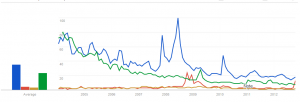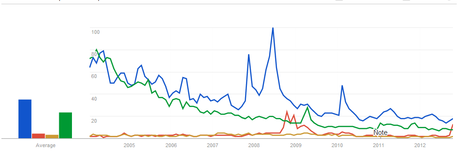 I had a good time playing around with google trends last week and figured I’d see what else I could uncover.This week I looked at trends in google searches related to renewable energy and energy conservation. Just like last week, the graphs below all peak at 100, which marks the peak search frequency. All other values are relative to the peak. Also, the searches are specific to the input term. Searches for “hydroelectric” will not include searches for the same term in other languages like Spainish (hidroeléctrico) or Korean (수력 발전의), homonyms are also not included; results for the search hydroelectric will not include searches for dams
I had a good time playing around with google trends last week and figured I’d see what else I could uncover.This week I looked at trends in google searches related to renewable energy and energy conservation. Just like last week, the graphs below all peak at 100, which marks the peak search frequency. All other values are relative to the peak. Also, the searches are specific to the input term. Searches for “hydroelectric” will not include searches for the same term in other languages like Spainish (hidroeléctrico) or Korean (수력 발전의), homonyms are also not included; results for the search hydroelectric will not include searches for dams
Because energy efficiency is the lowest hanging fruit in fixing our energy mess, I was first curious to see trends in the generic terms renewable energy and energy efficiency (figure 1). The chart shows that renewable energy is searched for almost twice as much as energy efficiency, despite the fact that energy efficiency is the least expensive way of lowering our greenhouse emissions quickly compared to renewables. Moreover, only a few people are employed by the renewable energy industry, whereas everyone can do more to become more energy efficient. It’s just not as sexy (but maybe the Nest will change that).

Figure 1:Frequency of Google searches for renewable energy and energy efficiency .
Secondly, I looked at the search trends in the major types of energy used to generate electricity. Unsurprisingly, coal was the most frequently searched for term followed by natural gas, renewable energy, nuclear energy, and hydro electric. Although nuclear and hydroelectric generate far more electricity than more high-tech renewables, searches for renewable energy was slightly higher than both. Searches for renewable energy would be even higher given that it’s a blanket term for several technologies.

Figure 2: Google search frequency for major energy sources, coal, natural gas, renewable energy, nuclear energy, hydroelectric
Trends in which types of renewable energy were generating the most interest on Google showed that interest in renewables tended to move together remarkably closely. Similar to searches for “climate change” discussed last week, Google searches for renewable energy are less frequent since 2010. Furthermore, Google searches for all types of renewable energy had a surprisingly regular annual cycle with troughs of interest every year in July and August (the trend was even more pronounced when restricted to Google searches in the United States alone). Finally, searches for solar energy were higher than for wind energy or for renewables, despite the fact that all of the other sources make up a much higher percentage of the total energy supply.

Figure 3: Google search trends for different renewable energy technologies by year: solar energy, wind energy, hydroelectric, biomass, and clean coal (which doesn’t exist)
I thought though it would be cool to see what potential clean energy technologies folks were searching. Did we stop dreaming of a cleaner world? or is there a tech I’m not hip to?
?

Figure 4: Google trends for the terms fuel cell, cold fusion, carbon sequestration, and clean coal (which again doesn’t exist). The mid-2008 fuel cell peak represented the first production Honda fuel cell car.
Finally, I’ll leave you with one more Google trend for you to mull over on your own:

Figure 5: Google trend for the search term environment.

